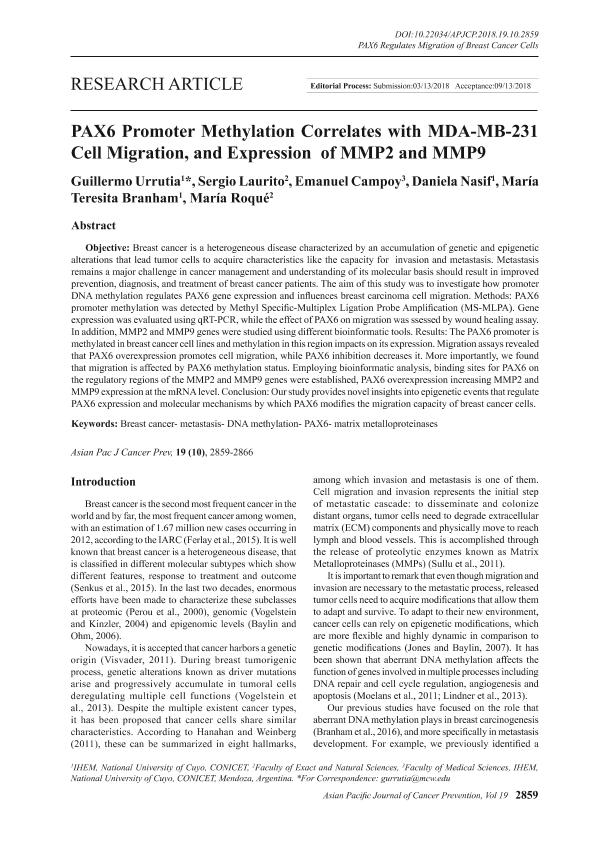Mostrar el registro sencillo del ítem
dc.contributor.author
Urrutia, Guillermo Alejandro

dc.contributor.author
Laurito, Sergio Roberto

dc.contributor.author
Campoy, Emanuel Martin

dc.contributor.author
Nasif, Daniela Lucía

dc.contributor.author
Branham, Maria Teresita

dc.contributor.author
Roque Moreno, Maria

dc.date.available
2020-01-09T15:25:54Z
dc.date.issued
2018-10
dc.identifier.citation
Urrutia, Guillermo Alejandro; Laurito, Sergio Roberto; Campoy, Emanuel Martin; Nasif, Daniela Lucía; Branham, Maria Teresita; et al.; PAX6 promoter methylation correlates with MDA-MB-231 cell migration, and expression of MMP2 and MMP9; Asian Pacific Organization Cancer Prevention; Asian Pacific Journal of Cancer Prevention; 19; 10; 10-2018; 2859-2866
dc.identifier.issn
1513-7368
dc.identifier.uri
http://hdl.handle.net/11336/94124
dc.description.abstract
Objective: Breast cancer is a heterogeneous disease characterized by an accumulation of genetic and epigenetic alterations that lead tumor cells to acquire characteristics like the capacity for invasion and metastasis. Metastasis remains a major challenge in cancer management and understanding of its molecular basis should result in improved prevention, diagnosis, and treatment of breast cancer patients. The aim of this study was to investigate how promoter DNA methylation regulates PAX6 gene expression and influences breast carcinoma cell migration. Methods: PAX6 promoter methylation was detected by Methyl Specific-Multiplex Ligation Probe Amplification (MS-MLPA). Gene expression was evaluated using qRT-PCR, while the effect of PAX6 on migration was ssessed by wound healing assay. In addition, MMP2 and MMP9 genes were studied using different bioinformatic tools. Results: The PAX6 promoter is methylated in breast cancer cell lines and methylation in this region impacts on its expression. Migration assays revealed that PAX6 overexpression promotes cell migration, while PAX6 inhibition decreases it. More importantly, we found that migration is affected by PAX6 methylation status. Employing bioinformatic analysis, binding sites for PAX6 on the regulatory regions of the MMP2 and MMP9 genes were established, PAX6 overexpression increasing MMP2 and MMP9 expression at the mRNA level. Conclusion: Our study provides novel insights into epigenetic events that regulate PAX6 expression and molecular mechanisms by which PAX6 modifies the migration capacity of breast cancer cells.
dc.format
application/pdf
dc.language.iso
eng
dc.publisher
Asian Pacific Organization Cancer Prevention

dc.rights
info:eu-repo/semantics/openAccess
dc.rights.uri
https://creativecommons.org/licenses/by-nc-sa/2.5/ar/
dc.subject
BREAST CANCER
dc.subject
DNA METHYLATION
dc.subject
MATRIX METALLOPROTEINASES
dc.subject
METASTASIS
dc.subject
PAX6
dc.subject.classification
Biología Celular, Microbiología

dc.subject.classification
Ciencias Biológicas

dc.subject.classification
CIENCIAS NATURALES Y EXACTAS

dc.title
PAX6 promoter methylation correlates with MDA-MB-231 cell migration, and expression of MMP2 and MMP9
dc.type
info:eu-repo/semantics/article
dc.type
info:ar-repo/semantics/artículo
dc.type
info:eu-repo/semantics/publishedVersion
dc.date.updated
2019-10-23T19:29:48Z
dc.journal.volume
19
dc.journal.number
10
dc.journal.pagination
2859-2866
dc.journal.pais
Irán

dc.description.fil
Fil: Urrutia, Guillermo Alejandro. Consejo Nacional de Investigaciones Científicas y Técnicas. Centro Científico Tecnológico Conicet - Mendoza. Instituto de Histología y Embriología de Mendoza Dr. Mario H. Burgos. Universidad Nacional de Cuyo. Facultad de Ciencias Médicas. Instituto de Histología y Embriología de Mendoza Dr. Mario H. Burgos; Argentina
dc.description.fil
Fil: Laurito, Sergio Roberto. Consejo Nacional de Investigaciones Científicas y Técnicas. Centro Científico Tecnológico Conicet - Mendoza. Instituto de Histología y Embriología de Mendoza Dr. Mario H. Burgos. Universidad Nacional de Cuyo. Facultad de Ciencias Médicas. Instituto de Histología y Embriología de Mendoza Dr. Mario H. Burgos; Argentina
dc.description.fil
Fil: Campoy, Emanuel Martin. Consejo Nacional de Investigaciones Científicas y Técnicas. Centro Científico Tecnológico Conicet - Mendoza. Instituto de Histología y Embriología de Mendoza Dr. Mario H. Burgos. Universidad Nacional de Cuyo. Facultad de Ciencias Médicas. Instituto de Histología y Embriología de Mendoza Dr. Mario H. Burgos; Argentina
dc.description.fil
Fil: Nasif, Daniela Lucía. Consejo Nacional de Investigaciones Científicas y Técnicas. Centro Científico Tecnológico Conicet - Mendoza. Instituto de Histología y Embriología de Mendoza Dr. Mario H. Burgos. Universidad Nacional de Cuyo. Facultad de Ciencias Médicas. Instituto de Histología y Embriología de Mendoza Dr. Mario H. Burgos; Argentina
dc.description.fil
Fil: Branham, Maria Teresita. Consejo Nacional de Investigaciones Científicas y Técnicas. Centro Científico Tecnológico Conicet - Mendoza. Instituto de Histología y Embriología de Mendoza Dr. Mario H. Burgos. Universidad Nacional de Cuyo. Facultad de Ciencias Médicas. Instituto de Histología y Embriología de Mendoza Dr. Mario H. Burgos; Argentina
dc.description.fil
Fil: Roque Moreno, Maria. Consejo Nacional de Investigaciones Científicas y Técnicas. Centro Científico Tecnológico Conicet - Mendoza. Instituto de Histología y Embriología de Mendoza Dr. Mario H. Burgos. Universidad Nacional de Cuyo. Facultad de Ciencias Médicas. Instituto de Histología y Embriología de Mendoza Dr. Mario H. Burgos; Argentina
dc.journal.title
Asian Pacific Journal of Cancer Prevention

dc.relation.alternativeid
info:eu-repo/semantics/altIdentifier/url/http://journal.waocp.org/article_69903_1459356ca0bf062e32e822d1a247d04c.pdf
dc.relation.alternativeid
info:eu-repo/semantics/altIdentifier/doi/http://dx.doi.org/10.22034/APJCP.2018.19.10.2859
Archivos asociados
